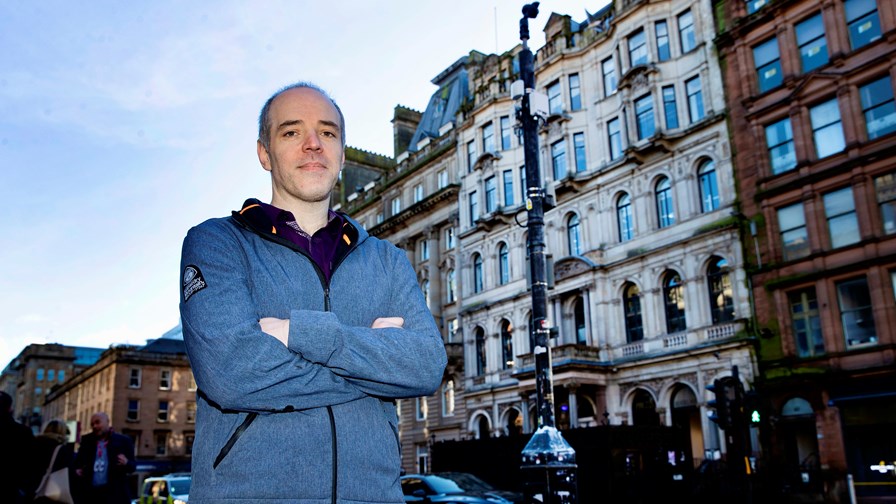
Three chief networks officer Iain Milligan at one of the small cell Open RAN sites in Glasgow.
- Open RAN is gaining traction with more and more network operators
- In the UK, Three is exploring its potential with a small cell rollout
- The operator is using Mavenir technology deployed on sites run by Boldyn Networks
Open RAN is finally starting to gain traction with a number of different operators around the world. Much of the new action taking place is in North America and Europe, where UK operator Three is the latest to introduce the disaggregated radio access network technology into its network with a small cells trial in the Scottish city of Glasgow.
In the past few months, the Open RAN sector has witnessed major deployment announcements from AT&T in the US and Canada’s Telus, while Verizon has confirmed the breadth of its Open RAN-enabled rollout, also in the US.
At the other end of the scale, but still of great interest to the global mobile network operator community because it will add to the industry bank of use cases, is the small cell rollout planned by Three. The UK national mobile operator is looking to improve the experience of its customers (currently more than 10 million) by densifying its current national 4G/5G network not just be adding more macro sites (it already has 4,700) but also by using small cells mounted on so-called ‘street furniture’ (such as bus shelters, CCTV camera poles and street lighting) in urban areas. The deployment is part of the Small Cells ORAN in Dense Areas (SCONDA) Project and is receiving funding from a £9.1m pot provided by the Open RAN-supportive UK government via the UK Telecoms Innovation Network (UKTIN) organisation.
Three plans to deploy radios and Open RAN software from Mavenir at 51 sites across Glasgow (where it has thousands of customers) over the next 15 months, with 20 sites being deployed in the initial rollout phase. Those sites will be run alongside the operator’s existing mobile network infrastructure and link to the operator’s existing core network. Neutral host operator Boldyn Networks is to acquire the sites and deploy the equipment, while Accenture has been contracted for testing and benchmarking tasks, and engineering firm AWTG is the overall project lead. The target is for the first site to go live during the second quarter of this year, the deployment of an automated mobile network management system from P.I. Works to be activated in the third quarter of 2024, and the rollout to be completed during the first quarter of 2025. The lessons learned from the deployment will then be implemented into its future strategy.
The move will enable Three to check out the potential of Open RAN technology and work with a new vendor in the form of Mavenir, as well as help it to figure out how it can aim to achieve the UK government-set target of having 35% of mobile traffic running over open and interoperable network infrastructure by 2030. For the Three team, led by chief network officer Iain Milligan (pictured above), trialling Open RAN in a rural setting wouldn’t provide it with the insights it needs for the future – hence the Glasgow location, with the small cells set to be located in areas of significant network congestion, such as Glasgow Central train station and the popular shopping area of Buchanan Street.
Three has already trialled non-Open RAN small cell technology in high mobile data traffic volume areas in the English city of Leeds and found that such technology improved 5G downstream speeds by up to 15 times in the immediate vicinity of the small cell and by up to 25% in the broader area.
In Glasgow, it is expecting a 61% increase in coverage in the small cell areas and an average increase in data connectivity of 35%.
“The big challenge we have is… congestion. And that’s where the more people there are, the busier it gets… on the network,” and the addition of small cells will help to address that, noted Milligan in this LinkedIn post. “Right now we have quite a complex network with lots of different technology vendors, and trying to make them all work in the best way is difficult. This new technology enables you to join them together and make them operate effectively together” to solve the congestion challenges, he added.
What will be interesting, of course, is what happens in the near future if regulators approve the planned merger of Three with Vodafone UK, which is further down the track with its Open RAN strategy, having deployed live sites in multiple locations, including the towns of Torquay and Exmouth – see Vodafone readies its Open RAN ‘golden cluster’.
Vodafone UK has worked with Mavenir in the past on its Open RAN strategy but more recently has sourced its Open RAN software, as well as radios, from Samsung and additional radio units form NEC. If the merger gets the go-ahead, Mavenir might have another bite at the Vodafone Open RAN cherry.
- Ray Le Maistre, Editorial Director, TelecomTV
Email Newsletters
Sign up to receive TelecomTV's top news and videos, plus exclusive subscriber-only content direct to your inbox.




